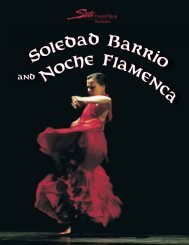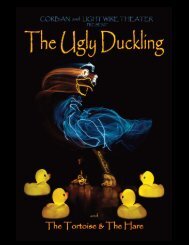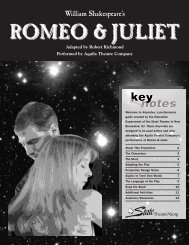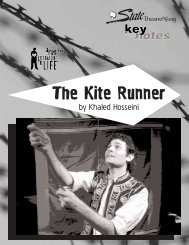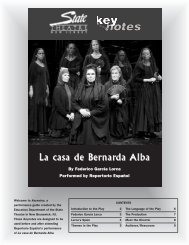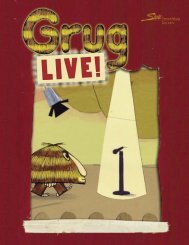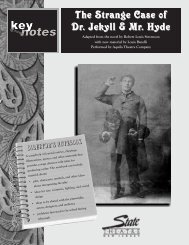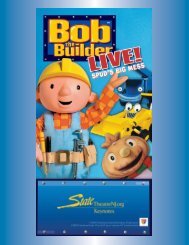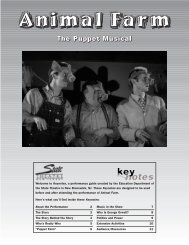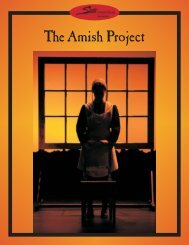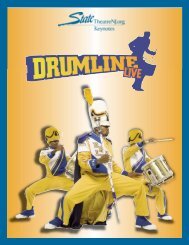Parsons Dance & East Village Opera Company - State Theatre
Parsons Dance & East Village Opera Company - State Theatre
Parsons Dance & East Village Opera Company - State Theatre
- No tags were found...
Create successful ePaper yourself
Turn your PDF publications into a flip-book with our unique Google optimized e-Paper software.
P ARSONS D ANCE ANDEAST VILLAGE OPERA COMPANYRemember me
W ELCOME2Welcome to the <strong>State</strong> <strong>Theatre</strong>’sperformance of Remember Me, acollaboration between <strong>Parsons</strong><strong>Dance</strong> and the lead vocalists of <strong>East</strong><strong>Village</strong> <strong>Opera</strong> <strong>Company</strong>. Described asa “rock dance opera,” the show uses21st-century arrangements of classicopera tunes as the soundtrack for thestory of a dangerous love triangle.To enhance your appreciation andenjoyment of the performance, theseKeynotes provide background and contexton the performers, the production, and theart forms.ContentsWelcome ..............................................................2The Program ......................................................3Caught ..................................................................4Remember Me ....................................................5The Artists............................................................6The Music......................................................7-11Resources ..........................................................12Keynotes are made possible by agenerous grant from Bank of AmericaCharitable Foundation.The <strong>State</strong> <strong>Theatre</strong>’s education program is funded in part by Bank of America Charitable Foundation, Colgate-Palmolive, The Geraldine R. Dodge Foundation, E & G Foundation, Gannett Foundation, The William G. & Helen C.Hoffman Foundation, The Horizon Foundation for New Jersey, Johnson & Johnson Family of Companies, J. SewardJohnson, Sr. 1963 Charitable Trust, Karma Foundation, The Blanche and Irving Laurie Foundation, McCraneFoundation, MetLife Foundation, Mid Atlantic Arts Foundation, National Starch, New England Foundation for theArts, New Jersey <strong>State</strong> Council on the Arts, Pennsylvania Performing Arts on Tour, PNC Foundation, Bill & CathyPowell, The Provident Bank Foundation, PSE&G, Robert Wood Johnson Foundation, TD Bank, and Wachovia WellsFargo Foundation. Their support is gratefully acknowledged.This tour of <strong>Parsons</strong> <strong>Dance</strong> and <strong>East</strong> <strong>Village</strong> <strong>Opera</strong> <strong>Company</strong> is made possible by a grant from MidAtlantic Arts Foundation with support from the National Endowment for the Arts.Funding has been made possible inpart by the New Jersey <strong>State</strong>Council on the Arts/Department of<strong>State</strong>, a partner agency of theNational Endowment for the Arts.The performance of <strong>Parsons</strong> <strong>Dance</strong> and <strong>East</strong> <strong>Village</strong> <strong>Opera</strong> <strong>Company</strong> is part of the<strong>State</strong> <strong>Theatre</strong>’s Scientists Exploring the Arts program, which is made possible bythe generous support of National Starch and Chemical.United is theofficial airline ofthe <strong>State</strong> <strong>Theatre</strong>.The Heldrich is the officialhotel of the <strong>State</strong> <strong>Theatre</strong>.Keynotes are produced by the EducationDepartment of the <strong>State</strong> <strong>Theatre</strong>,New Brunswick, NJ.Lian Farrer, Vice President for EducationOnline at www.<strong>State</strong><strong>Theatre</strong>NJ.org/KeynotesKeynotes for <strong>Parsons</strong> <strong>Dance</strong> and <strong>East</strong> <strong>Village</strong> <strong>Opera</strong><strong>Company</strong> written and designed by Lian Farrer.Edited by Jennifer Cunha.© 2010 <strong>State</strong> <strong>Theatre</strong>Find us at www.<strong>State</strong><strong>Theatre</strong>NJ.orgContact: education@<strong>State</strong><strong>Theatre</strong>NJ.orgThe <strong>State</strong> <strong>Theatre</strong>, a premier nonprofit venue for theperforming arts and entertainment.
T HE P ROGRAM3CAUGHT1982Choreography by David <strong>Parsons</strong>Lighting Concept and Design by David <strong>Parsons</strong>Music by Robert FrippCostume by Judy WirkulaREmEmBER mE<strong>Parsons</strong> <strong>Dance</strong>, in collaboration with the lead vocalists and music of <strong>East</strong> <strong>Village</strong> <strong>Opera</strong> <strong>Company</strong>2009Produced by David <strong>Parsons</strong>, David Harrison and Brick Wall ManagementDirected and Choreographed by David <strong>Parsons</strong>Production Design by Jason ThompsonLighting Design by Howell BinkleyMusical Arrangement by <strong>East</strong> <strong>Village</strong> <strong>Opera</strong> <strong>Company</strong>Sound Design by Will ReidCostume Designer by Austin ScarlettOverture to Le Nozze di Figaro (The Marriage of Figaro) ......................................Wolfgang Amadeus Mozart“La Danza” from Soirées Musicales..................................................................................Gioacchino Antonio Rossini“Maria, Mari” (Folk song) ............................................................................Vincenzo Russo and Eduardo Di Capua“Habanera” from Carmen ............................................................................................................................Georges Bizet“Che gelida manina” from La bohème ..............................................................................................Giacomo PucciniFlower Duet from Lakmé ..................................................................................................................................Léo Delibes“La donna é mobile” from Rigoletto........................................................................................................Giuseppe Verdi“Ave Maria” (sacred) ......................................................................................................................................Franz Schubert“O mio babbino caro” from Gianni Schicchi ....................................................................................Giacomo Puccini“Nessun dorma” from Turandot ............................................................................................................Giacomo Puccini“Ebben? Ne andró lontana” from La Wally ........................................................................................Alfredo Catalani“When I Am Laid in Earth” from Dido and Aeneas ................................................................................Henry Purcell“The Butterfly Duet” (Love Duet) from Madama Butterfly ........................................................Giacomo Puccini
C AUGHT4The program opens with the company’s signature work,Caught. This solo piece has been performed hundreds oftimes for more than 28 years, and is included in just aboutevery David <strong>Parsons</strong> <strong>Dance</strong> performance. It is set to RobertFripp's eerie score of phased electric guitars.Caught plays with optical illusion through the precisecoordination of lighting and movement. This demanding piecerequires the soloist to perform more than 100 leaps in lessthan six minutes. It begins with the dancer standing indarkness. Moving from spotlight to spotlight, he becomesvisible, performs a variety of movements, then dissappearsagain into the darkness. A moment later, he reappears in adifferent spot and executes more moves. Then, with no stringsor wires, the dancer flies. In a series of strobe-lit ‘snapshots’that flash very rapidly, he appears to levitate across the stagewithout touching down. The illusion is created by the dancer,whose brief airborne moments are ‘caught’ in the momentaryflash of light. As he travels across the stage performing leaps,tilts, and splits, he holds a control that allows him to time thestrobe light to illuminate him only while he is in midair.photo: Gene SchiavoneCaught, pictured above with dancer Miguel Quinones,was originally choreographed and performed by David<strong>Parsons</strong> himself. His performance is captured on video atwww.youtube.com/watch?v=JfVXRn6dNJ0DAVID PARSONS ON CAUGHTFrom an interview on PBS’ EGG - The Arts ShowI think I have always beenfascinated with air time—thefeeling of freedom. I mean,man has always tried to getoff the planet, and thefeeling when you're floatingin the air, that moment whenyour hair just gets to thatpoint—I always try tocapture that in dance, and in using trampolines in theater.It's always a very exciting moment for me. I think we got thisthing where everybody on the planet has dreamt of flying;I'm still looking for someone who hasn't. And it's anincredible thing to stumble upon as an artist—that question.I think as an artist you're constantly looking for things toinspire you, and one of the things that I picked wasphotography and light, how light captures images. (I tookphotography in high school.) So, photography has definitelyinspired and changed the way I choreograph.The idea of Caught came from working withphotographers. You would go up and you would hit a shape,and then you would change it slightly. And you got so goodat just knowing where that shape was from an outside eyeand I thought, “Well, what if I could control that light andmake a dance just in the air, but you could only see it whenthe strobe went off?” And that's how Caught was born; Istarted experimenting with a dark room, with a strobe light.I performed Caught for nine years as a solo, but only Idid it. Then I started to teach other dancers the piece andnow many people do it: men and women. One of my mostwonderful experiences in dance was working with MikhailBaryshnikov. He saw Caught, and we worked on it togetherin a studio at the Metropolitan <strong>Opera</strong> House in New York,and it was just a wonderful afternoon watching him leaparound. It was like watching hundreds of photographs of thisgreat dancer live.
R EMEMBER M E5Remember me, but, ah, forget my fate!—from Dido and Aeneas, by Henry PurcellRemember Me is a modern retelling of a classic story of atragic love triangle. The storyline is woven around a selectionof well-known opera arias and tells a shadowy tale ofjealousy and rivalry. With contemporary dance, live andrecorded music, video projections, complex digital lightingand visual effects, this piece is the most ambitiousproduction created by <strong>Parsons</strong> <strong>Dance</strong> in its 22-year history.Choreographed and directed for the stage by David<strong>Parsons</strong>, Remember Me is a high-energy mix of contemporaryAmerican dance, opera, and rock music. It combines theathleticism of <strong>Parsons</strong> <strong>Dance</strong> with the exhilarating live vocalperformances of <strong>East</strong> <strong>Village</strong> <strong>Opera</strong> <strong>Company</strong> (EVOC). David<strong>Parsons</strong> and EVOC lead vocalists Tyley Ross and AnnMarieMilazzo created a storyline that connects EVOC's signatureopera arias with David <strong>Parsons</strong>' original choreography.Riffing on the concept of the “jukebox musical” (such asTwyla Tharp’s Movin’ Out, which was set to the music of BillyJoel), Tyley Ross describes Remember Me as “a kind ofjukebox opera.”David <strong>Parsons</strong> remarked, "To take Rossini, Mozart, Bizet,Puccini, Verdi and put them into a contemporary eveningwith a storyline is something that's different, is somethingthat's risky, and you feel it, you feel that we're taking thatrisk, and it has paid off."<strong>Parsons</strong> said he creates a different dance vocabulary foreach of his pieces. "We really do try and have an incrediblevariety of language, and that language is dance, and thatmeans movement. So we dig down deep, and [withRemember Me] we came up with something that was verygrounded, very physical—with some interesting arms andlines we haven't done before."Costumes for Remember Me are by New York City-basedfashion designer Austin Scarlett, who competed in the firstseason of Project Runway.
A BOUT T HE A RTISTS6PARSONS DANCE<strong>Parsons</strong> <strong>Dance</strong> is an internationally-renowned contemporary dance company under theartistic direction of dancer/choreographer David <strong>Parsons</strong>. <strong>Parsons</strong> <strong>Dance</strong> is committed tocreating and performing American dance works of extraordinary artistry that are engaging anduplifting to audiences throughout the world. The company tours nationally and internationally,including an annual season in its home community of New York City. The company includes 11full-time dancers and maintains a repertory of more than 70 works choreographed by David<strong>Parsons</strong>. Since 1985, <strong>Parsons</strong> <strong>Dance</strong> has toured an average of 32 weeks per year, to a total ofmore than 250 cities, 35 countries, six continents and millions of audience members. Manymore have seen <strong>Parsons</strong> <strong>Dance</strong> on PBS, Bravo, A&E Network, and the Discovery Channel. Inaddition to choreography and performance, <strong>Parsons</strong> <strong>Dance</strong> is committed to audiencedevelopment and arts education for participants of all ages and all levels of artistic experience.In partnership with Marymount Manhattan College, <strong>Parsons</strong> <strong>Dance</strong> offers an annual, accredited“Summer Intensive” study program for professional and pre-professional (student) dancers thatattracts students from across the United <strong>State</strong>s and several foreign countries.EAST VILLAGE OPERA COMPANYTyley RossAnnMarie Milazzo<strong>East</strong> <strong>Village</strong> <strong>Opera</strong> <strong>Company</strong> (EVOC) was formed in New York City's <strong>East</strong> <strong>Village</strong> in 2004 byCanadians Peter Kiesewalter and Tyley Ross. Featuring a virtuosic rock band and string section,the group dedicates itself to re-imagining the greatest opera arias through the use of moderninstruments and creative arrangements, balancing tradition with renewal. EVOC has recordedthree CDs: La Donna (2004), The <strong>East</strong> <strong>Village</strong> <strong>Opera</strong> <strong>Company</strong> (2005), and Olde School (2008).Olde School was nominated for a Grammy in the Classical Crossover Album category. The bandhas performed at the Sundance Film Festival, the nationally-televised Miss USA pageant, andthe world premiere of The Da Vinci Code in Hong Kong. Their PBS Special, EVOC Live, receiveda 2006 Emmy Award.AnnMarie Milazzo is an arranger, composer, and lyricist who has done the vocalarrangements for Spring Awakening, Next To Normal, Bright Lights, Big City, and the featurefilm, The Marc Pease Experience. Her most recent work includes a new musical, Pretty Dead Girl,which premiered at The Sundance Film Festival, and the musical Sea Change. AnnMarie is thelyricist for Franco Dragone's Carmen, and is currently writing lyrics for Cirque du Soleil's, LeRêve. As a singer, she has worked with artists such as Angelique Kidjo, Carlos Santana, andJonatha Brooke.Tyley Ross, a native of Ottawa, Canada, has been a street busker, a cartoon and voice artist,acted for the small and large screen, written and recorded two solo albums, and performed asa guest soloist with orchestras across Canada and the US. After being discovered by PeteTownshend of The Who in 1994, Tyley was cast in the title role of the Canadian premiere of TheWho’s Tommy. He spent the next ten years on musical stages across North America, in leadroles at the Shaw and Stratford Festivals, and on Broadway. In 2001, Tyley was introduced toPeter Kiesewalter; their experiments with recording opera arias in a variety of modern contextsled to the unveiling of the <strong>East</strong> <strong>Village</strong> <strong>Opera</strong> <strong>Company</strong> in 2004. Tyley received his master’sdegree in voice studies from London’s Central School of Speech and Drama.
T HE M USIC7Mozart: Overture to Le nozze di Figaro (1786)Before Mozart, opera was seen as an exclusively upper-class art form, reflected not onlyin its audiences but also in the characters on stage. Things changed with Le nozze di Figaro(The Marriage of Figaro), the story of a servant who stands up to his master and eventuallyoutwits him. The opera was dangerously subversive for its time in the years leading up tothe French Revolution, presaging the spirit of rock and roll by almost 200 years—inparticular, the Who’s “Won’t Get Fooled Again,” with its call for revolution and change.Rossini: “La danza” from Les soirées musicales (1835)Words by Carlo PepoliThe tarantella, of which this song is an example, is a lively Neapolitan folk dance. Thename is derived from ‘tarantola’ (tarantula), a poisonous spider common to the region.Tradition had it that victims of a tarantula bite could avoid death by frenzied dancing—asort of “musical exorcism.” While there’s no record of Rossini’s tarantella having effectedany miracle cures, this lightning-fast song has become a concert favorite.The moon is already over the ocean;Mamma mia, we'll jump about!It’s a beautiful time for dancing,Anyone who’s in love won’t miss it.Quickly ladies, come hereAnd dance round and round,A handsome, cheerful ladWill have a turn with every girl.As long as a star twinkles in the skyAnd the moon shinesThe handsomest boy and prettiest girlWill dance all night.Faster, faster, faster,Faster, faster, faster,Mamma mia, we'll jump about!Leap and leap, go round and round,Every couple swirls about,Now they advance, now they retreat,and returns to the assault.Holding closely, closely the blonde, then thebrunette, go here and there;Then go with the redhead, with the pale onetake a break.Long live the ball, round and round, I am aKing, I am a PashaIt is the greatest delight in the world, thedearest pleasure!
T HE M USIC8Di Capua: “Maria, Marì”Lyrics by Vincenzo RussoEduardo Di Capua will live on forever as the composer of “O, sole mio,” which has beensung by everyone from Caruso and Pavarotti to Bryan Adams and Elvis Presley (“It’s Now orNever”). Di Capua’s second-most famous song is “Maria, Mari” (which, to the best of ourknowledge, was never recorded by Elvis.) It’s a typical Neapolitan serenade of the ‘cometo-the-window’genre.Open, window!Let me see Marie’s face,For I’m down in the street,Hoping to see her.I have no peace, not even for an hour:I make the night come day,in order to be around here all the time,hoping to talk to her!Oh, Marie, oh, Marie,How much sleep I’m losing over you!Let me sleep,holding you in my arms awhile!Bizet: “L’amour est un oiseau rebelle” (Habanera) from Carmen (1875)Libretto by Henri Meilhac and Ludovic HalévyWhile the “Habanera,” in our opinion, doesn’t really sound like a traditional Spanish folksong, Bizet was successful in establishing the character of Carmen in this aria: that of acoquettish, flirtatious, and extremely confident seductress.Love is a rebellious birdThat no one can tame.And you call him quite in vainIf it suits him to refuse.Nothing works, neither threats nor prayers,One man speaks well, the other keeps silent;And it’s the other one that I prefer—He hasn’t said a word, but I like him.Love! Love is a bohemian child.It has never, ever recognized the law.If you love me not, then I love you,And if I love you, watch out!The bird you thought you’d caughtFlapped its wings and flew away.Love stays away, you can wait for it;When you no longer expect it, there it is!All around you, quickly, quickly,It comes, it goes and then comes again!You think you’ve got hold of it, it escapesyou,You think you’ve escaped it, it’s gotten holdof you!If you love me not, then I love you,And if I love you, watch out!
T HE M USIC9Puccini: “Che gelida manina” from La bohème (1896)Libretto by Giuseppe Giacosa and Luigi IllicaLa bohème is the story of four hipsters in the Latin Quarter ofParis, a neighborhood that shares historic similarities with the <strong>East</strong><strong>Village</strong> in New York. In this aria a poor poet and his sicklyneighbor fumble in the dark hallway looking for her lost keys. Heaccidentally touches her hand, and falls instantly in love. He bareshis soul to her. Knowing perhaps that he’s said too much, he asks,“Now that you know me, will you tell me: who are you?”What a cold little hand,let me warm it for you.What’s the use of looking?We won’t find it in the dark.But luckily it’s a moonlit night,and we have the moon near ushere.Wait, miss, I will tell you in twowordswho I am, what I do, and how I live.May I?Who am I? I am a poet.What do I do? I write.And how do I live? I live.In my carefree poverty I lavishlyspendrhymes and love songs like a greatlord.When it comes to dreams andvisionsand castles in the air,I’ve the soul of a millionaire.Now and then all the jewels arestolen from my safe by twothieves:a pair of pretty eyes.They came in with you just now,and my usual dreams, my lovelydreams,melted at once into thin air!But I pay no regard to the theft,for left in their place is hope!Now that you know all about me,Speak, tell me who you are.Please do!Delibes: “Dôme épais, le jasmin” (Flower Duet) from Lakmé (1883)Libretto by Edmond Gondinet and Philippe GilleAn Indian girl and her female slave slip off to the water’s edge while singing aboutbirds, lotuses, and the river’s current… renowned in the opera world for its Sapphic subtext.Immortalized in our time as the soundtrack for British Airways and countless other TVcommercials.LAKME:Under the dome where the jasmineThickly entwines with the rose,Riverbanks in bloom, in the cool morning,They call to us.Ah! Let us float along,Following the fleeting current:On the rippling waves,With an unhurried handLet us reach the bankWhere the bird sings.Under the dome, the white jasmine,They call to us!MALLIKA:Under the dome where the white jasmineThickly entwines with the rose,On the flowery riverbank,Laughing at the morning,Come, let us go down togetherLet us gently floatOn its charming waves,Let us follow the fleeting currentOn the rippling waves.With an unhurried handCome, let us reach the bankWhere the spring sleepsAnd the bird singsUnder the dome, under the white jasmine;Ah, let us go down together!LAKME:I don’t know what sudden fearTakes hold of meWhen my father goes alone to theiraccursed city,I tremble, I tremble with fear.MALLIKA:May Ganesha protect himUp to the pond where happily frolicThe swans with wings of snow,Come, let us gather the blue lotus.
T HE M USIC10Verdi: “La donna è mobile” from Rigoletto (1851)Libretto by Francesco Maria PiaveIt wasn’t this opera’s degrading representation of women that angeredthe elite, nor was it the boozing and whoring. What really pissed off theEuropean royal courts was the portrayal of a boozing and whoring king.The opera was based on a play by Victor Hugo titled Le roi s’amuse (TheKing Amuses Himself) and set in the French court of Francois I. Hugo’splay was judged libellous and banned from performance for 50 years.When Verdi took up the story, he was forced by the censors to changethe title and center the story around a fictitious Duke of Mantua before itwas finally deemed suitable by the heavy-handed censors. This aria givesan accurate indication of the Duke’s character.Woman is fickle, like a feather in the windChangeable in both word and thought.Always a sweet, pretty face;Whether weeping or laughing, she is lying.Woman is fickle, like a feather in the windChangeable in both word and thought.Any man who trusts her is always miserable;The man who confides in her—reckless is his heart!Yet no man feels completely happyUnless he drinks of love on that bosom!Schubert: “Ave Maria” (1825)Schubert didn’t write this “Ave Maria.” Whathe did write was a song set to a Germantranslation of part of Sir Walter Scott’s poemThe Lady of the Lake. The poem is indeed aprayer to the Virgin Mary, which gavesomeone the bright idea of ‘borrowing’Schubert’s melody and replacing the wordswith the full text of the Roman Catholic prayer.Hail Mary, full of graceHail, the Lord is with youBlessed are you among women,And blessed is the fruit of your womb, Jesus.Holy Mary, mother of God,Pray for us sinners—now, and in the hour of ourdeath.Amen.Puccini: “Nessun dorma” from Turandot (1926)Libretto by Giuseppe Adami and Renato SimoniPuccini: “O mio babbino caro” from Gianni Schicchi (1918)Libretto by Giovacchino ForzanoThe singer begs for her father’s permission to pursue a loveinterest. That seems to be somewhat of an archaic dilemma inthis day and age, so we added the point of view of the coy butfrustrated lover. Our homage to the great Marvin Gaye is notrestricted to the bridge—knowing Marvin’s tragic fate at thehands of his father is one of the reasons we took a slightlymore sinister harmonic approach.Oh my dear Daddy,I like her, she is so beautifulI want to go to Porta RossaTo buy the ring.Yes, yes, I want to go there!And if I love her in vainI’d go to the Ponte Vecchio [a famous bridge in Florence]To throw myself into the Arno,I pine and I suffer!Oh God, I wish I were dead!Daddy, have pity!Have you ever watched a friend fall in love withpositively the wrong person? In Puccini’s final opera, theprotagonist Calaf loses his mind for the nasty PrincessTurandot. Having already reneged on one deal, Turandotagrees to another: if she is unable to discover Calaf’s truename by morning, she will marry him. However, if shedoes find out, she gets to cut off his head. Most guyswould run—Calaf chooses instead to sing this song.Puccini himself died before he could finish this opera.No one sleep! No one sleep!You too, o Princess,In your cold chamberYou watch the stars that tremble with loveand with hope!But my secret is locked inside me,No one will know my name! No, no!I will place it on your mouthWhen daylight shines!And my kiss will end the silencethat makes you mine!Disappear, o night! Set, you stars!Set, you stars! At dawn I will win!I will win! I will win!
T HE M USIC11Catalani: “Ebben? Ne andrò lontana” from La Wally (1892)Libretto by Luigi IllicaThere are many, many ways one can die in an opera. Besidesthe usual stabbing, strangling, drowning, poison swallowing, andthe ever-popular wasting away, you’ll find babies thrown into thefire, a soprano who leaps into an erupting volcano, and evendeath by singing. In true operatic style, the heroine of AlfredoCatalani’s La Wally throws herself into an avalanche. Fortunatelyfor us music lovers, before we get to the fatal leap, Wally singsthis gorgeous aria. In it, she determines to leave her Tyroleanvillage rather than be forced to marry a man she does not love.Ah well then! I shall go far awayLike the echo of the pious churchbellgoes away,There somewhere in the whitesnow;There amongst the clouds of gold,There where hope, hopeIs regret, is regret, is sorrow!O from my mother's cheerful houseWally is about to go away fromyou, from you!Quite far away, and perhaps to you,And perhaps to you, will nevermore return,Nor ever more see you again!Never again, never again!I will go away alone and far,There, somewhere in the whitesnow, I shall go,I will go away alone and farAnd amongst the clouds of gold!Purcell: “When I Am Laid in Earth” from Dido andAeneas (1689)Libretto by Nahum TateAccording Virgil’s Aeneid, Queen Dido of Carthageand Trojan War hero Aeneas fell madly in love. Aeneasis commanded by the gods to leave Carthage and sailto Italy, where he is destined to become the founderof Rome. Heartbroken that her lover has skippedtown, Dido asks to be remembered for how she livedher life and not for how she chooses to end it. Ourversion has an additional voice of remembrance: onethat binds the ending of one life to the beginning ofanother.When I am laid in earthMay my wrongs create no trouble in thy breastRemember me!But ah! Forget my fate!Puccini: Love Duet from Madama Butterfly (1904)Libretto by Luigi Illica and Giuseppe GiacosaLong before Miss Saigon, Puccini’s Madama Butterfly broke audiences’ hearts with the tragic tale ofa Japanese girl who put all her love and faith in the hands of a callous American officer. The gorgeous,sensuous love duet comes at the end of the first act, right after Cio-Cio San (a.k.a. Butterfly) hasmarried lieutenant Benjamin Franklin Pinkerton.CIO-CIO SANLove me with a tiny love,a childlike love,The kind that suits me.Love me, please.We are a people accustomed to small,humble, silent things,To a tenderness that lightly caresses,and yet is as vast as the heavens and thewaves of the sea.PINKERTONLet me kiss your dear hands.My Butterfly! How aptly they named you,fragile butterfly...CIO-CIO SANThey say that beyond the seaIf a butterfly falls into the hands of a man,It is pierced with a pinAnd fixed to a table!PINKERTONThere’s some truth in that.And do you know why?So that it won’t fly away.I’ve caught you...I press you to me, quivering.You’re mine!CIO-CIO SANYes, for life!PINKERTONCome, come!Cast all sad fears out of your heart!The night is peaceful. Look, everything isasleep.You’re mine, Ah, come!CIO-CIO SANAh! Lovely night! So many stars!I’ve never seen them so beautiful!Only twinkle sparkles and shinesWith the brilliance of an eye.Oh! So many eyes fixed and staring,Looking at us from all sides!In the sky, along the shore, out to sea...theheavens are smiling!Ah! Lovely night!In an ecstasy of love the sky is smiling!
R ESOURCES12BOOKSAppreciating <strong>Dance</strong>: A Guide to the World’s Liveliest Art, byHarriet R. Lihs. Princeton Book <strong>Company</strong>, 3rd edition, 2002.Fifty Contemporary Choreographers, by Martha Bremser.Routledge, 1999.<strong>Opera</strong> for Dummies, by David Pogue and Scott Speck. ForDummies, 1997.<strong>Opera</strong> 101: A Complete Guide to Learning and Loving <strong>Opera</strong>,by Fred Plotkin. Hyperion.VIDEOONLINE<strong>Parsons</strong> <strong>Dance</strong>www.parsonsdance.org<strong>East</strong> <strong>Village</strong> <strong>Opera</strong> <strong>Company</strong>www.eastvillageoperacompany.comThe San Diego <strong>Opera</strong>’s web guide to opera, with definitions,articles, and more.www.operapaedia.orgArkiv Music has an exhaustive selection of classical CDs andDVDswww.arkivmusic.comThe <strong>Parsons</strong> <strong>Dance</strong> <strong>Company</strong>: Fine Dining, Caught, Scrutiny(1992). Arthaus Musik.



